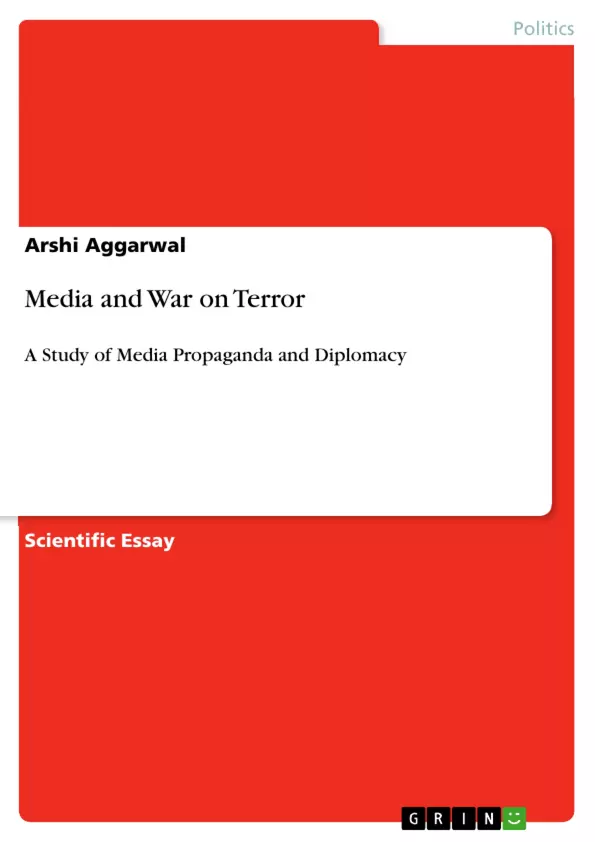In 2012, at least 67 journalists had been killed in action in different conflict areas across the globe, making it one of the deadliest years for media persons in action (CPJ, 2012). Never before in the recorded history, have so many journalists lost their lives in conflict zone. There was a time when media in war was treated at par with Red Cross Samaritans. But, now journalists are seen as polarised agents of either side (Aday et al., 2005: 6; CPJ, 2012). Perhaps the notion has befallen as a result of increasingly state controlled and propagated media content. Several scholars have researched and argued that in contemporary era, media objectivity is almost invisible and the tactics that make it biased are hidden from masses. Although, there is no deniability in the argument that media has the power to filter certain content in specific style to get desirable response from the public, but unfortunately, it has lost majority control over making that decision. Now it is being used by the governments as a tool to generate consensus over its operations, however outrageous they might be. Researches indicate that in case of ongoing ‘war on terror’ media has been effectively used to create mass support for war, dehumanise enemies, create a fake sense of victory and even as a strategic method to instil positive image in hostile countries. This paper is classified as follows. The first part deals with the concepts of framing, elite and pluralist theories and propaganda model suggested by Herman and Chomsky. Second part attempts to elaborate on the various roles that media plays in the war on terror under, with a brief discussion about the counter forces acting in the information technology that may revolutionise the war reporting in future and challenge the state’s control over the information flow like never before. Finally, the third section looks at how media can be used to instigate peace in conflict regions.
Inhaltsverzeichnis (Table of Contents)
- Introduction
- Media on War
- Framing and Propaganda
- Media in the Age of Terror
- Elite and Pluralist Models
- Media in War
- Democratic Peace Theory
- Media as a Faithful Servant
- National Integration and Hysteria
Zielsetzung und Themenschwerpunkte (Objectives and Key Themes)
This paper aims to analyze the role of media in the context of war, specifically examining how media framing, propaganda, and the interplay between elite and pluralist models influence public perception and policy. The paper focuses on the war on terror, highlighting how media coverage shapes public opinion and contributes to the dehumanization of enemies. The key themes explored in the text include:- Media framing and its impact on public opinion
- The influence of propaganda models on media coverage
- The role of elite and pluralist models in shaping media influence
- The impact of media on public support for war and conflict
- The dehumanization of enemies and the creation of hysteria through media framing
Zusammenfassung der Kapitel (Chapter Summaries)
Introduction
This section introduces the paper by highlighting the increasing dangers faced by journalists in conflict zones, the shift from media objectivity to state-controlled propaganda, and the role of media in shaping public opinion during the "war on terror." It outlines the key concepts of framing, elite and pluralist theories, and the propaganda model.Media on War
This chapter delves into the concept of media framing, arguing that media acts as a mediator between the public and administrators. The concept of framing is explored in detail, linking it to agenda setting and priming. The chapter further examines the propaganda model, which suggests that media is prone to bias driven by factors such as ownership, advertising, and political pressure.Media in War
This section investigates the role of media in conflict situations. It explores the democratic peace theory and its limitations in the context of the "war on terror." The chapter highlights how media often operates as a "faithful servant" of the government, promoting official narratives and silencing dissent. It also examines the impact of media on public perception of threats, contributing to the creation of hysteria and dehumanization of enemies.Schlüsselwörter (Keywords)
This paper focuses on the key themes of media framing, propaganda, elite and pluralist models, public opinion, war on terror, dehumanization, and the role of media in conflict zones. The research delves into theories like the democratic peace theory, Herman and Chomsky's propaganda model, and analyzes the impact of media coverage on public perception and policy.- Citar trabajo
- Arshi Aggarwal (Autor), 2013, Media and War on Terror, Múnich, GRIN Verlag, https://www.grin.com/document/285550



